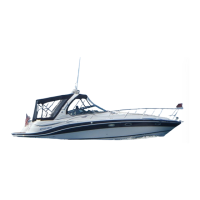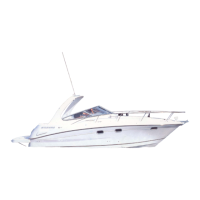Do you have a question about the Four winns 278 VISTA and is the answer not in the manual?
Contact details for Four Winns customer service, including address, phone, and email.
Explains the meaning of various warning symbols and notice boxes used in the manual.
Lists and describes the locations of various warning and certification labels on the boat.
Basic guidelines for becoming familiar with boat systems and safety equipment before operation.
Emphasizes the importance of understanding boat systems and manufacturer information.
Details required federal safety equipment and recommends additional items.
Outlines owner's responsibility for passenger safety and behavior aboard.
Discusses marine traffic laws and regulations for safe navigation.
Advises on safety precautions to take during thunderstorms while boating.
Discusses the dangers and legal implications of operating a boat under the influence.
Lists essential checks to perform before leaving the dock for a cruise.
General procedures for starting and operating the boat's engine.
Provides guidance and warnings regarding grounding and towing procedures.
Lists resources for boating courses, manuals, charts, and laws.
Explains federal and state laws requiring boat registration and displaying numbers.
Details requirements and procedures for reporting boating accidents.
Prohibits oil discharge and outlines penalties under federal law.
Covers regulations and environmental impact of garbage disposal at sea.
Discusses regulations for disposing of waste and garbage from boats.
Owner's responsibility for ensuring all required safety equipment is aboard.
Covers hazards, symptoms, and prevention of carbon monoxide poisoning.
Guidelines for safe operation, drugs, and alcohol.
Safety precautions for participating in water sports.
Introduction to seamanship rules, aids, and boater education resources.
Discusses USCG authority and state boating regulations.
Explains general right-of-way rules and vessel interactions.
Provides guidance for safe operation during nighttime and reduced visibility.
Explains the use and meaning of whistle signals for communication.
Explains the purpose and types of navigational aids.
Describes the function and appearance of lateral markers in navigation.
Details safe water markers used to indicate navigable channels.
Explains the three types of markers in the USWMS.
Provides guidance on selecting, securing, and deploying anchors.
Details the Winning Edge Owner Protection Plan and warranty coverage.
Explains the process and importance of warranty registration.
Outlines the procedure and conditions for transferring warranty coverage.
Encourages registration of ownership for pre-owned boats.
Lists key responsibilities of the boat owner related to operation and maintenance.
Mentions compliance with US Coast Guard and ABYC construction standards.
Safety precautions and general information regarding engine service.
Discusses the hazard of carbon monoxide in exhaust fumes.
Information on the function and importance of CO monitors.
Details about the engine and stern drive propulsion system.
Describes the stern drive propulsion system and its components.
Explains propeller terminology like diameter, pitch, and prop slip.
Details on raw water and fresh water cooling systems.
Explains how to control the boat's running angle using trim and tilt.
Information on the power tilt system for launching and trailering.
Guidance on using trim tabs to adjust boat attitude.
Explanation of the various gauges at the helm station.
Describes the function and importance of the tachometer gauge.
Explains how the speedometer works and its limitations.
Details the engine temperature gauge and its warnings.
Explains the function of the oil pressure gauge and potential issues.
Monitors battery condition and alternator performance.
Indicates the fuel level in the tank; readings are relative.
Provides visual indication of the outdrive's trim angle.
Optional gauge to detect gasoline vapors in the engine compartment.
Records elapsed engine operating time for maintenance scheduling.
Explains the function and proper use of the emergency stop switch.
Overview of control systems, throttle, and shift mechanisms.
Detailed instructions on operating the throttle and shift controls.
Procedures for shifting gears and controlling engine speed.
Explains the function of the neutral safety switch.
Guidelines for periodic inspection and lubrication of control systems.
Information on the rotary and tilt steering systems.
Details on adjusting the tilt steering wheel for driver comfort.
Explains propeller torque and its effect on steering.
Routine maintenance for steering cables and assemblies.
Instructions for winter storage of the steering system.
Overview of the boat's 12V DC and AC electrical systems.
Explains the dual battery system and its selector switch operation.
Guides on using battery selector switch positions for optimal battery life.
Information on the standard battery charger and its operation.
Explains the function of the voltmeter gauge.
Details various 12V electrical equipment and their locations.
Procedures for shutting down the electrical system when leaving the boat unattended.
Guidelines for connecting to and operating with shore power.
Safe procedures for connecting to shore power outlets.
Information on AC-powered equipment like chargers and refrigerators.
Explains GFCI function for protection against electrical shock.
Information on the optional generator and its operation.
Routine maintenance for batteries and wiring.
Tips for inspecting and maintaining electrical wiring.
Understanding and preventing stray current corrosion.
Explains galvanic corrosion and its causes.
Methods for preventing corrosion using anodes and proper maintenance.
Covers design and requirements for gasoline fuel systems.
Information on factory inspection and testing of fuel systems.
Details on locating and operating fuel fill deck plates.
Explains the function of anti-syphon valves in the fuel system.
Describes the fuel gauge and how to interpret its readings.
Explains how the fuel sender works and factors affecting readings.
Importance of fuel filters and their maintenance.
Safety warnings and maintenance for fuel system components.
Information on gasoline requirements and alcohol blends.
Safe procedures for fueling the boat at a marina.
Overview of the fresh water supply system components.
Details on priming, operating, and heating the water system.
Information on the boat's water heater and its operation.
Guidance on using the boat's shower and maintaining the system.
Optional system for managing grey water from sinks and showers.
How to connect to a dockside water supply for fresh water.
Information on the transom shower unit and its operation.
Details on standard porcelain head and VacuFlush sanitation systems.
Explains the operation of the VacuFlush toilet system.
Describes the overboard discharge option for the head system.
Procedures for pumping out the waste holding tank at a marina.
Maintenance procedures for water and waste system components.
Instructions for cleaning water tank vents and filter screens.
Steps for draining and winterizing the fresh water system.
Ensuring adequate air circulation in the engine compartment to prevent hazards.
Methods for ventilating the cabin to prevent CO buildup.
How hull drainage systems remove water from the boat.
Operation and maintenance of forward and aft bilge pumps.
How the self-bailing cockpit design drains water overboard.
Details on the electric stove, microwave, and refrigerator.
Information on the stereo system and optional TV/DVD player.
Details on the optional flat screen TV and DVD player.
Operation and maintenance of the air conditioner/heater unit.
Maintenance and proper use of exterior rails and deck fittings.
Operation and cleaning of the companionway door and hatch.
Care and cleaning instructions for windshields and plexiglass windows.
Specific cleaning advice for plexiglass components.
Information on the integrated swim platform and boarding ladder.
Location and accessibility of storage compartments under the helm seat.
Description of the integrated bow platform for anchoring.
Details on the optional electric windlass system.
Information on the optional radar arch for navigation equipment.
Operation of the electric lift for the engine hatch.
Details on the dinette table and V-berth seating configurations.
How to access storage below the V-berth cushions.
Description of sleeping quarters and storage in the mid cabin.
Information on adjustable helm seats and stern seating options.
How to set up and store the aft cockpit table.
Details on optional sunpads for foredeck lounging.
Guidelines for cleaning and maintaining interior fabric and upholstery.
Recommendations for cleaning interior fabrics and spot removal.
Instructions for removing and cleaning privacy curtains.
Procedures for cleaning and maintaining exterior vinyl and carpets.
Specifics on cleaning vinyl upholstery with recommended products.
Guidance on cleaning and maintaining removable exterior carpets.
General advice for carpet cleaning and stain removal.
Information on obtaining replacement upholstery parts.
Overview of weather covers, bimini tops, and camper tops.
Step-by-step instructions for installing and removing canvas covers.
Precautions for trailering the boat with weather covers installed.
Information on the standard bimini top and its installation.
Instructions for installing the optional camper canvas for full enclosure.
Information on the optional cockpit cover for short-term storage.
Safety warning regarding carbon monoxide buildup when using canvas covers.
Guidelines for properly protecting the boat during winter dry dock storage.
Maintenance tips for weather covers, including cleaning and winterizing.
Principles behind hull design for strength and weight.
Routine maintenance to preserve the gel coat's beauty and finish.
Explains common weathering effects like chalking, fading, and blistering.
Methods for removing various types of stains from the boat's exterior.
Step-by-step procedures for repairing scratches, gouges, and cracks.
A basic procedure for repairing minor scratches in the gel coat.
Repair methods for cosmetic damage like gouges and stress cracks.
Information on applying antifouling paint for hull protection.
Importance of proper hull support during lifting or storage.
Cleaning and maintenance of interior laminate surfaces.
Cleaning and waxing laminated fiberglass components.
Care instructions for woodgrain trim and steering wheel.
Proper methods for cleaning acrylic plastic components.
Cleaning instructions for the optional Flexiteek swim platform.
Comprehensive guide to winterizing the boat's systems for storage.
Steps to prepare the boat before lifting it for winter storage.
Procedures to follow after the boat has been lifted for storage.
Procedures for flushing the engine cooling system.
Scheduled maintenance tasks for various boat systems.
Basic information on trailer regulations and matching.
Federal requirements for trailer registration and tire information.
Understanding the trailer's maximum load capacity and GVWR.
Guidance on selecting the correct hitch ball size and type.
Description of key trailer components like bunks and tongue.
Procedures for hitching and backing the trailer.
Step-by-step guide for properly hitching the trailer.
Guidance on backing up the trailer, especially with surge brakes.
Comprehensive checklist and tactics for safe trailering.
Essential checks to perform before trailering the boat.
Maintenance tips for the trailer's exterior finish and bunks.
How to clean and maintain the trailer's painted or galvanized finish.
Instructions for inspecting and replacing bunk boards.
Procedures for inspecting and repairing trailer axles and bearings.
Step-by-step guide for removing the hub to inspect bearings.
How to inspect and replace wheel bearings and seals.
Steps for reinstalling the hub and tightening lug nuts.
A comprehensive checklist for preparing the boat before launch and cruise.
Safe fueling procedures, recommendations, and post-fueling checks.
Guidelines for safely loading passengers and distributing gear.
Basic steps for starting the boat's engine.
Techniques for maneuvering the boat, including leaving the dock and stopping.
Procedures for safely departing from the dock.
Guidance on bringing the boat onto plane safely.
How to use trim tabs and power trim for optimal boat attitude.
Explains the function of the tilt/trim control switch.
Proper use and importance of navigation lights.
How to react to hazardous conditions like storms and fog.
Actions to take when encountering storms while boating.
Guidelines for operating safely in fog conditions.
Procedures to follow if the boat runs aground.
Recognizing and understanding navigational warning markers.
Steps to take in case of a collision with another vessel.
Safety procedures and guidelines for dealing with fires on board.
Preparing and responding to various emergency situations.
Actions to take if the boat begins to take on water.
Procedures for dealing with capsizing and man overboard incidents.
Guidance on approaching and docking the boat.
Techniques for safe and effective docking procedures.
| Brand | Four winns |
|---|---|
| Model | 278 VISTA |
| Category | Boat |
| Language | English |











